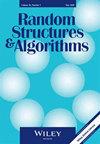伪随机图上的站点渗透
IF 0.8
3区 数学
Q4 COMPUTER SCIENCE, SOFTWARE ENGINEERING
引用次数: 3
摘要
我们考虑伪随机d $$ d $$正则图上的顶点渗透。第二作者先前的研究证实了在p=1d $$ p=\frac{1}{d} $$处存在从小组分到线性(在nd $$ \frac{n}{d} $$)尺寸组分的相变。在超临界状态下,我们的主要结果恢复了最大分量大小的尖锐渐近,并表明所有其他分量通常都要小得多。此外,我们还考虑了最大分量的其他典型性质,如边数、长循环的存在性和可扩展性。在亚临界状态下,我们加强了可能分量大小的上界。本文章由计算机程序翻译,如有差异,请以英文原文为准。
Site percolation on pseudo‐random graphs
We consider vertex percolation on pseudo‐random d$$ d $$ ‐regular graphs. The previous study by the second author established the existence of phase transition from small components to a linear (in nd$$ \frac{n}{d} $$ ) sized component, at p=1d$$ p=\frac{1}{d} $$ . In the supercritical regime, our main result recovers the sharp asymptotic of the size of the largest component, and shows that all other components are typically much smaller. Furthermore, we consider other typical properties of the largest component such as the number of edges, existence of a long cycle and expansion. In the subcritical regime, we strengthen the upper bound on the likely component size.
求助全文
通过发布文献求助,成功后即可免费获取论文全文。
去求助
来源期刊

Random Structures & Algorithms
数学-计算机:软件工程
CiteScore
2.50
自引率
10.00%
发文量
56
审稿时长
>12 weeks
期刊介绍:
It is the aim of this journal to meet two main objectives: to cover the latest research on discrete random structures, and to present applications of such research to problems in combinatorics and computer science. The goal is to provide a natural home for a significant body of current research, and a useful forum for ideas on future studies in randomness.
Results concerning random graphs, hypergraphs, matroids, trees, mappings, permutations, matrices, sets and orders, as well as stochastic graph processes and networks are presented with particular emphasis on the use of probabilistic methods in combinatorics as developed by Paul Erdõs. The journal focuses on probabilistic algorithms, average case analysis of deterministic algorithms, and applications of probabilistic methods to cryptography, data structures, searching and sorting. The journal also devotes space to such areas of probability theory as percolation, random walks and combinatorial aspects of probability.
 求助内容:
求助内容: 应助结果提醒方式:
应助结果提醒方式:


